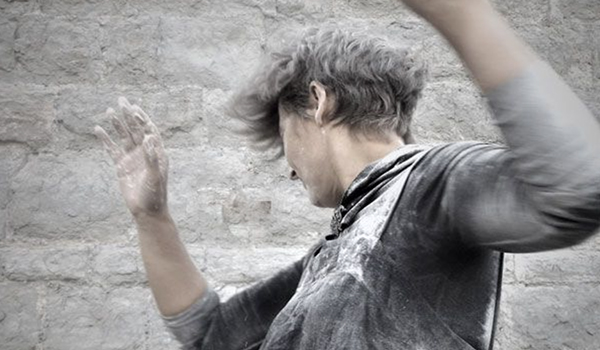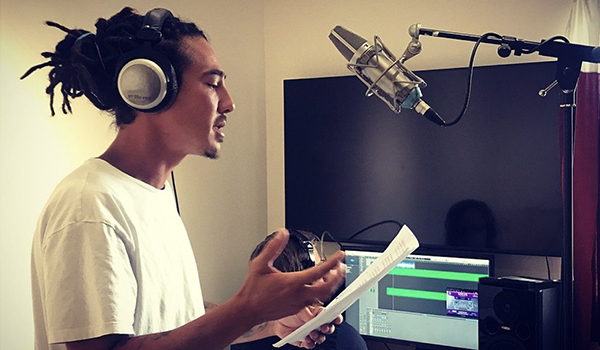Image credit: Viv Gordon on Coastal walk creating She Walks…
Viv Gordon Company’s work is a campaign to increase visibility, voice and community with adult survivors of childhood sexual abuse (CSA). In their new digital artwork, She walks…, the company call for allies to open up conversations around childhood sexual abuse to support survivors with new animation and track. This new digital artwork combines music, hand-drawn animation, spoken word and song and is a collaboration with rapper JPDL. We caught up with Artistic Director Viv Gordon to find out more about the work.
Your new work is called, She walks… tell us what it’s about?
She walks… is a digital artwork combining music, song, spoken word, rap and hand drawn animations. It is the first part of a wider project called Restless that uses imagery from walking in coastal landscapes to talk about the experience of living as a survivor of childhood sexual abuse – ideas of being isolated and exposed, of navigating challenging territory and occupying marginal, liminal spaces. The central metaphor running through the project is the restless sea, slowly and insistently changing the landscape – just as activism changes culture through continuous collective action. She walks… sits at the midpoint of the larger work – the character has survived and despite an inner fragmentation and experiences of dissociation, she is instinctively propelled forward.
The track ends with the idea that change is possible – it is a turning point. It’s not that everything gets better from there on – I don’t really believe in recovery as such – I think we learn to live with what happens to us and reclaim some of what we’ve lost – trust, connection, hope… I will never not have been abused, I will never not be a survivor – it’s not something that happened years ago and is now over – I live with the impact of it every day – lots of us don’t survive and I am acutely aware of that.
Walking has been a massive part of my journey – I’m making up for lost time – I had a developmental delay when I was little because of the trauma – so walking is a victory. It’s what I do to feel good, to find solace, to stay connected with my body, to work things out when my brain is in chaos and to write. The Restless project draws on a long tradition of artists and activists walking to create change – what do we do when we’ve had enough? We march.
She walks… is based on a poem I wrote after walking a 110 mile stretch, the South West Coast Path, inspired specifically by the landscape around Portland in Dorset which is rich in contradictions – at once beautiful, wild and ancient and deeply scarred with quarrying, a Ministry of Defense site surrounded by razor wire and a high walled prison. The resonance for me is the impact of abusive, defensive or controlling patriarchal structures set against the wonder and resilience of the natural world.
You have a long history of art and activism. What do you believe art can do in terms of political action? Why is this so important to you?
The arts have always been subversive – a way to commentate on culture and for those outside the traditional structures of power to have a voice, galvanise community, gain critical mass and agitate for change. My activism is to be visible and vocal as a survivor, to reject narratives of victimhood, secrecy and shame – I didn’t do anything wrong and I’m done with keeping other people’s dirty secrets.
Talking about childhood sexual abuse is also deeply subversive. There’s a reason we have been silent as a culture on this subject and that is because it is so pervasive, woven into the very fabric of society. We’re finding that out since Operation Yewtree with a never-ending parade of celebrities, politicians, sports coaches, clergy and teachers starting to be called to account. And this is just the tip of an incomprehensible iceberg with the vast majority of abuse happening in families, in homes, behind closed doors. Most people are surprised to know there are an estimated 11 million adult survivors of childhood sexual abuse in the UK. This is an astounding number especially when you consider how little cultural representation we have. Change happens when marginalised people come together and represent their interests – community is powerful.
Survivors face injustice at every turn – the justice system is woefully inadequate, survivors struggle to access appropriate support and are more likely to experience homelessness, addiction, emotional distress, long term health conditions, suicide and so on. But it runs even deeper than this. Philosopher Miranda Fricker formulated the idea of hermeneutical injustice in her 2007 book Epistemic Injustice: Power and the Ethics of Knowing. Hermeneutical injustice is when we lack the language or framework to understand or communicate our own experiences because those experiences have not been conceptualised adequately in our culture. This is because of the historic exclusion of survivor voices.
This is certainly true for me – as I grew up no-one ever talked about abuse – I didn’t hear the words childhood sexual abuse until I was in my 20s. And although this is changing it’s still something that rarely gets airtime outside of our safe spaces – therapy, friendships and support groups. The idea of Restless is to contribute to a cultural lexicon to enable us to be better at talking about abuse – the way that songs and poems can – we all share that experience of feeling deep emotions and a song lyric playing over in our minds that helps us understand and articulate what we are feeling. That is my hope for Restless – to be part of developing a shared language.

Image credit: Viv Gordon by Carl Simpson
It’s an incredibly powerful subject matter, what can audiences expect from She walks…?
She walks… has been developed with some incredible collaborators. We used a poem I had written as our starting point – Rapper JPDL and I co-wrote the lyrics which are spoken, sung (more on that later) and rapped. Experimental composer Quinta (part of Collectress) wrote the music. Award winning animator, Lou Sumray created hand drawn charcoal images – incredibly she uses 24 drawings per second.
The result is something authentic, beautiful and haunting – the music has a trip hop feel and the animation connects us to nature with its organic aesthetic. The temptation with work about abuse is to tidy it all up and make it more palatable – there’s a raw chaos to She walks… that chimes with the experiences and fragmentation that survivors share – it’s untamed and all the more alive for it.
We hope that survivor audiences will connect with the story and see something of themselves in it – the lyrics talk about the experience of dissociation, feeling like our bodies are far away or numbed, as well as the drive to keep going and the belief that something better is possible. We want to share hope but more than that we want to reach out to other survivors and say ‘What you feel is real, is normal in the context of trauma, there’s nothing wrong with you, you’re miraculous, you don’t need to hide away, your voice matters’.
The work is not just for survivors though – it’s for everyone – we all have difficult times and right now the pandemic is making life really tough for so many – one of the things we have in common is the ability to connect with nature and find solace and inspiration there – even if it’s looking out of the window at the birds or feeling the rain on our faces while we queue for supplies!

Image: Rapper JPDL in the studio
For this project you are working in new ways – in terms of your practice, what has been most fruitful from this endeavour? How is it to work as an artist in the context of Covid restrictions?
The whole Restless project is an experiment to see if the very primal act of walking and the artistic response to landscape can throw up new ways of understanding survivor experiences. So far so good – in September I did a shorter 55 miles walk along the West Somerset Coast to write a new song – it responds to the landscape around Hinkley Point nuclear power station – an ugly toxic blot that dominates the landscape for many miles. The ambition is to keep walking, writing and recording until we have a whole album of work.
When we started She walks… I thought I would read the poem I’d written over some beautiful music and didn’t imagine singing for a minute. I have never sung before and have loads of hang ups around it – it’s one of the impacts of abuse for me – the tightness in my throat from a lifetime of silence – the inability to breathe deeply… When it started to develop as a song, I really wanted someone else to sing it – but all of my work is about survivor voice, so it was clear I had to give it a go. I had some singing lessons and booked extra time in the recording studio for crying and smoking fags. It’s not an accomplished vocal but it’s honest – for me it’s all about bringing my whole self and my vulnerability to the table – that’s my activism. If I worried about not being good enough, I’d never do anything.
Before the pandemic we’d already worked out that my work as a theatre artist needed to have digital elements. Survivor community exists most strongly online and so to reach people we knew we needed to embrace that. Covid just sped things up for us. It’s exciting to explore what’s possible digitally that isn’t just a poor translation of live work. We were able to collaborate remotely with some of us in the south west, one in Athens and another in Bradford. It’s been interesting to see how close we’ve become – I’ve never met Lou in real life, but she feels like an old friend. I’m always incredibly grateful when brilliant artists join me to make work. It’s not easy subject matter to engage with – for me I live with it every day so I may as well do something with it – look it in the eye you might say – but for others it’s a choice to enter that territory and support the cause – its deeply moving and affirming that people want to join us to make change.
Finally, where can we see it? How can we get involved?
We’re holding a launch event on the 25th November – the first day of the international campaign 16 days of activism against gender-based violence. It’s a free online event offering a first look at the work, a panel discussion with all the artists and a reading of the poem that inspired the track. Sign up here.
We really want people to join us in making a noise about abuse – so we are running the #MyLineInTheSand campaign at the same time. It’s an invitation to survivors and allies to write words of hope, rage and solidarity in the sand (or in anything – paint, salt, pebbles….) and share on social media. You can follow us on our Facebook page Viv Gordon Company or on Twitter and Instagram on @VivGordonCo to get involved.
